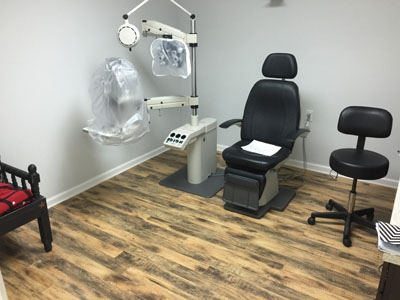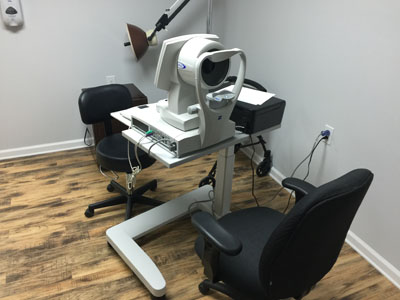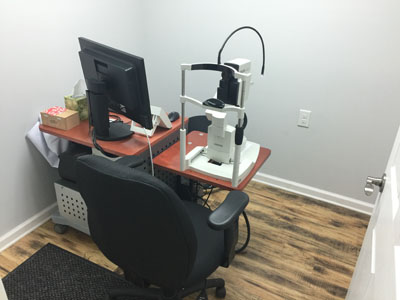Our Services
Comprehensive Eye Exams
 Regular eye exams are an invaluable tool in maintaining healthy eyes by detecting and preventing disease in both adults and children. Some diseases develop slowly without causing pain or vision loss. Early detection of any problems can reduce the risk of further harm and allow for a choice of treatment options. Part of your exam includes the following procedures: Vision Check, Eye Pressure Check, Slit Lamp Examination, Dilated Eye Exam, Refraction for Glasses & Contact Lenses and Glaucoma Screening Testing as well as a series of other computerized tests to determine the health of your eyes.
Regular eye exams are an invaluable tool in maintaining healthy eyes by detecting and preventing disease in both adults and children. Some diseases develop slowly without causing pain or vision loss. Early detection of any problems can reduce the risk of further harm and allow for a choice of treatment options. Part of your exam includes the following procedures: Vision Check, Eye Pressure Check, Slit Lamp Examination, Dilated Eye Exam, Refraction for Glasses & Contact Lenses and Glaucoma Screening Testing as well as a series of other computerized tests to determine the health of your eyes.
Cataract Surgery
A cataract is a clouding of the natural lens inside the eye. A cataract is a gradual thickening of the lens that causes the lens to become so clouded that light is either distorted or cannot reach the back of the eye (the retina) for transmission to the brain. When left untreated, cataracts will eventually cause blindness in most cases.
Advanced technology lenses (multi-focal and accommodating lenses), which reduce your need for glasses following cataract surgery, are an exciting new option that we are proud to offer our patients!
Glaucoma Diagnosis and Management
Glaucoma, the leading cause of blindness and visual impairment in the United States, is an eye disease that can lead to a permanent loss of vision. We provide all diagnostic and treatment options for glaucoma care. Glaucoma generally provides no warning signs or symptoms of disease, making testing an important part of a full vision exam. We utilize the latest and most advanced computerized tests to diagnose glaucoma. For those who require treatment options, there are many, including topical eye drop self-administration, laser treatment, which can be utilized for precise, quick healing, and more advanced surgical options, for those difficult and advanced cases of glaucoma.
Macular Degeneration Evaluation and Treatment
 The term "macular degeneration" includes many different eye diseases, all of which affect central, or detail vision. Age-related macular degeneration is the most common of these disorders, mainly affecting people over the age of 60. Although there are many types of macular degeneration, age-related macular degeneration (AMD or ARMD) is the most common type. Age-related macular degeneration occurs in two forms: "wet" age-related macular degeneration and "dry" age-related macular degeneration. "Wet" age-related macular degeneration is less common but more aggressive in its development to severe and, often, permanent central vision loss. "Dry" age-related macular degeneration is the more common type and is more slowly progressive in causing loss of vision.
The term "macular degeneration" includes many different eye diseases, all of which affect central, or detail vision. Age-related macular degeneration is the most common of these disorders, mainly affecting people over the age of 60. Although there are many types of macular degeneration, age-related macular degeneration (AMD or ARMD) is the most common type. Age-related macular degeneration occurs in two forms: "wet" age-related macular degeneration and "dry" age-related macular degeneration. "Wet" age-related macular degeneration is less common but more aggressive in its development to severe and, often, permanent central vision loss. "Dry" age-related macular degeneration is the more common type and is more slowly progressive in causing loss of vision.
What is wet age-related macular degeneration?
Wet age-related macular degeneration occurs when abnormal blood vessels begin to grow underneath the retina. These new blood vessels (known as choroidal neovascularization or CNV) tend to be very fragile and often leak blood and fluid. The blood and fluid raise the macula from its normal place at the back of the eye and interfere with the retina's function and causes the central vision to blur. Under these circumstances, vision loss may be rapid and severe. Some patients, however, do not notice visual changes despite the onset of CNV. Therefore, periodic eye examinations are very important for patients at risk for CNV. Once CNV has developed in one eye, whether there is a visual loss or not, the other eye is at relatively high risk for the same change.
Diabetic Retinopathy

If you have been diagnosed with diabetes, you may be at risk of losing your vision since your body does not utilize sugar properly and, when the sugar levels rise, damage to the retinal blood vessels may occur. This injury to the retinal vessels is known as Diabetic Retinopathy. Diabetic Retinopathy is the leading cause of blindness in working-age adults.





